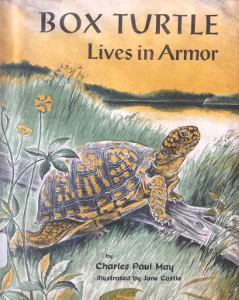Box Turtle: Lives in Armor

Author:
Charles Paul May
Illustrator:
Jane Castle
Publication:
1960 by Holiday House
Genre:
Nature, Non-fiction, Science
Series:
Life-Cycle Stories ![]() Members Only
Members Only
Pages:
47
Current state:
This book has been evaluated and information added. It has not been read and content considerations may not be complete.
Book Guide
Search for this book used on:
The box turtle is a gentle creature, despite its fierce-looking head. When in danger, it has only to retreat into its shell and close the lid. This remarkable armor has kept the turtle walking on the earth from the time of the dinosaurs up to the present.
This story relates how the shell both limits one turtle's life and saves it. The story contrasts its way of life with that of other animals living in the same territory: the other reptiles (water turtle, snake, lizard), and the amphibians (salamander, frog).
The engaging text raises thought-provoking questions in the young reader's mind. Why is a turtle a reptile? What are reptiles? Why isn't a salamander a reptile? What is a land egg? Then, as the story unfolds, the answers do too. Thus, by narrative means, the science concept of classification is presented.
At the same time, the reader has been stimulated to observe wildlife on his own. Several kinds of turtles make good pets. Instructions on how to care for them are included.
An authority on reptiles and amphibians, Professor Arthur N. Bragg, Department of Zoology, University of Oklahoma, has closely read the text.
From the dust jacket
The most effective armor on a land animal is the shell of a turtle. The turtle you may have in your yard is easy to care for and dates back to the dinosaurs. The tough shell is a great protection, but is also a hindrance in getting around. Read about other types of reptiles, and how their way of life contrasts with that of the turtle. Many kinds of turtles live in North America, and some make fine pets. Instructions for keeping them are included at the end of this informative book.
From the book
To view an example page please sign in.
Please sign in for additional information about this book.
Find This Book
Search for this book used on:



